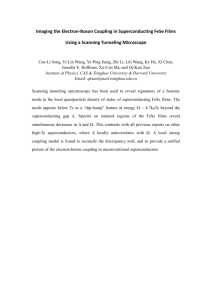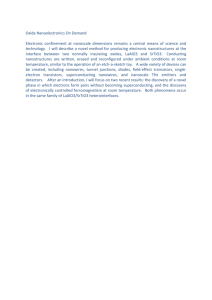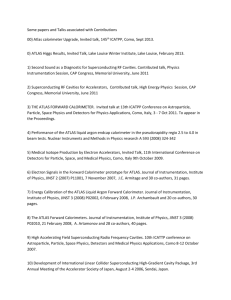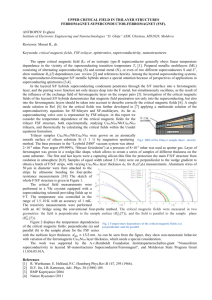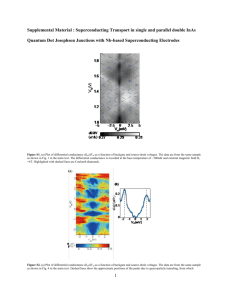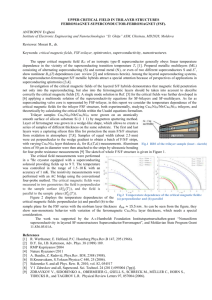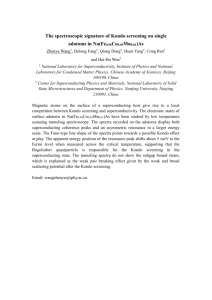Abrir trabalho completo
advertisement
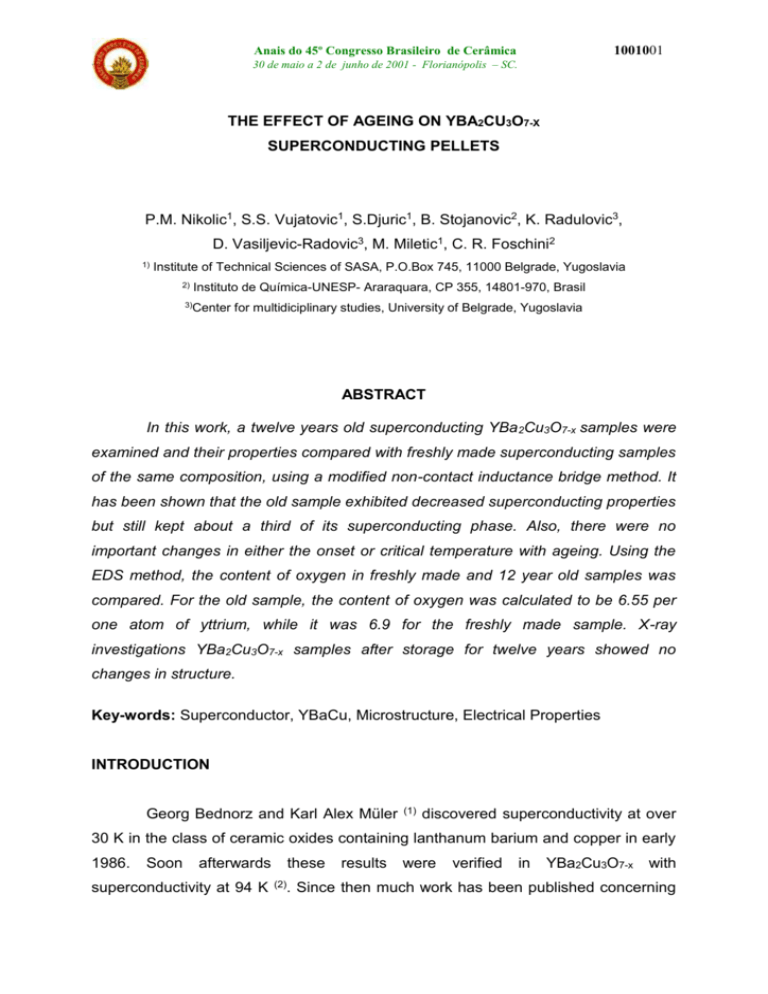
1001001 Anais do 45º Congresso Brasileiro de Cerâmica 30 de maio a 2 de junho de 2001 - Florianópolis – SC. THE EFFECT OF AGEING ON YBA2CU3O7-X SUPERCONDUCTING PELLETS P.M. Nikolic1, S.S. Vujatovic1, S.Djuric1, B. Stojanovic2, K. Radulovic3, D. Vasiljevic-Radovic3, M. Miletic1, C. R. Foschini2 1) Institute of Technical Sciences of SASA, P.O.Box 745, 11000 Belgrade, Yugoslavia 2) Instituto de Química-UNESP- Araraquara, CP 355, 14801-970, Brasil 3)Center for multidiciplinary studies, University of Belgrade, Yugoslavia ABSTRACT In this work, a twelve years old superconducting YBa 2Cu3O7-x samples were examined and their properties compared with freshly made superconducting samples of the same composition, using a modified non-contact inductance bridge method. It has been shown that the old sample exhibited decreased superconducting properties but still kept about a third of its superconducting phase. Also, there were no important changes in either the onset or critical temperature with ageing. Using the EDS method, the content of oxygen in freshly made and 12 year old samples was compared. For the old sample, the content of oxygen was calculated to be 6.55 per one atom of yttrium, while it was 6.9 for the freshly made sample. X-ray investigations YBa2Cu3O7-x samples after storage for twelve years showed no changes in structure. Key-words: Superconductor, YBaCu, Microstructure, Electrical Properties INTRODUCTION Georg Bednorz and Karl Alex Müler (1) discovered superconductivity at over 30 K in the class of ceramic oxides containing lanthanum barium and copper in early 1986. Soon afterwards superconductivity at 94 K these (2). results were verified in YBa2Cu3O7-x with Since then much work has been published concerning 1001002 Anais do 45º Congresso Brasileiro de Cerâmica 30 de maio a 2 de junho de 2001 - Florianópolis – SC. this high Tc superconductor. For example, Kamimura and Sano Kamimura (4) Almond et al. (3) and Namura and recently studied tight binding Hamiltonians for this superconductor. (5) investigated the modulated optical reflectance characterization of superconducting YBa2Cu3O7-x thin films and microwave devices. The influence of oxygen vacancies in CuO chains is studied in the framework of the extended two – sublattice Mitsual model where pseudospins variables are used for the description of two possible positions of oxygen ions synthesized in 1987 (7) (6). In our laboratory YBa2Cu3O7-x pellets were and their superconducting properties examined (8). Some of these samples were kept and after twelve year we were able to measure their superconducting properties again. In this work we compared some new and twelve years old data for the same samples in order to detect differences due to ageing. EXPERIMENTAL PROCEDURE Transport properties of superconducting YBa 2Cu3O7-x pellets, produced twelve years ago, were examined again. Their critical temperature was measured using the same modified noncontact method (8) as twelve years ago. It consisted of an inductance bridge whose scheme is given in Figure 1. An oscillator was employed as a generator whose frequency could be changed between 10 Hz and 200 kHz. This oscillator fed two coils L1 and L2 connected in a series, and wound in the opposite way. Coils L1 and L2 were inductively coupled with coils L3 and L4, respectively. Resistors R1 and R2, each of 22 k, and a variable resistor R3 of 10 k were inserted in this bridge. Both coils L2 and L4 had soft ferrite cores, which were used to increase the sensitivity of the bridge. During the measuring Figure 1: Modified noncontact inductance bridge for critical temperature measurements. procedure, the superconducting sample was placed between coils L2 and L4. Then Eddy currents were induced in the sample, by coils L2 and L4, producing a magnetic field, which modified self-inductances of both L2 and L4 coils and also the mutual inductance Anais do 45º Congresso Brasileiro de Cerâmica 1001003 30 de maio a 2 de junho de 2001 - Florianópolis – SC. (L24) of these coils. The response of this inductance bridge was measured using a phase detector. Finally the output of the phase detector was connected to a personal computer using an AD converter. The temperature of the sample was measured with a copper – constantan thermocouple which was attached to the sample with a thermoconductive paste. Both old and new superconducting samples were pellets 8 mm in diameter and 2 mm thick, and they were placed in a sample holder made of a pertinax insulator. This sample holder containing the superconducting sample was always put in the same position in the narrow space between coils L2 and L4. This was ensured by a special lead. The measuring procedure was rather simple. Measurements were first made at room temperature in the sample in (U) and the sample out (Uo) positions. Afterwards the superconducting sample with its holder and the copper – constantan thermocouple were cooled down by immersion in liquid nitrogen. After several minutes the cold superconducting sample with its holder, was put again between coils L2 and L4, as quickly as possible (about 1 and 2 seconds). The sample was then warmed up relatively slowly, up to 10 seconds, and the change of the voltage from the bridge was registered by the PC as a function of time. The time dependency of the relative bridge response (U/U o) for the 12 years old superconducting sample is given in Figure 2, with crosses. We have recently produced fresh superconducting samples of YBa2Cu3O7-x using the same technology and quality of starting compounds (Y2O3, Cu2O and BaCO3) as explained elsewhere (7). In the same Figure the change of the relative bridge response for a new freshly synthesized sample is given with open circles. The response of the inductance bridge was registered every 10 milliseconds. In Figure 2 we have shown every tenth measuring point, to make the picture more clear. At the same time, every 10 ms, the temperature of the sample was registered. One end of the copper – constantan thermocouple was stuck Figure 2: The relative bridge response vs. time for the 12 to the sample, while the other end was permanently years old (x) and for new (o) superconducting sample. 1001004 Anais do 45º Congresso Brasileiro de Cerâmica 30 de maio a 2 de junho de 2001 - Florianópolis – SC. immersed in a Dewar vessel with liquid nitrogen. The measuring signal for this thermocouple was also connected to a computer using the same AD converter. The obtained thermal characteristics of our twelve – year – old superconducting sample could be easily compared with the results reported in 1988. for the same sample (8). RESSULTS AND DISCUSSION The relative bridge response diagrams (U/Uo) versus time, for both old (aged) and freshly synthesised samples had similar shapes (Figure 2). There was a sudden change of level after the sample was cooled down to liquid nitrogen temperature, then the level remained almost unchanged for several seconds until it started to increase almost linearly reaching an inset after another few seconds. The main difference between these two diagrams is the distance between superconducting and nonsuperconducting levels. For the freshly made sample this distance was about 76% while it was only about 24 % for the twelve years old sample. We might conclude that the superconducting relative ratio of the aged and new freshly made sample is about three. It is obvious that after twelve years the superconducting YBa2Cu3O7-x sample did not lose its superconducting properties, but they decreased greatly in degree down to about one third of the initial value. Changes in the superconducting relative ratio might depend on the storing method of a particular sample. Our samples were kept in an ordinary laboratory cupboard only protected against dust and mechanical injuries. X-ray work was also done on both samples. No differences in Bragg's reflection pattern were detected between the old and new samples. Also, for the old sample no differences were found in either Bragg’s reflection patterns or the ratio of their intensities, for diffractograms made twelve years ago and now. In our opinion xray measurements are not sensitive enough for the purpose of detecting such small changes in structure. Finally, we may add that the modified non-contact inductance bridge arrangement is a fast method, which can easily be used to measure the critical temperature of high - Tc ceramic superconductors. This method can also be employed to detect either the relative proportion of the superconducting phase in Anais do 45º Congresso Brasileiro de Cerâmica 1001005 30 de maio a 2 de junho de 2001 - Florianópolis – SC. high – Tc ceramic samples or to follow changes in superconducting properties with ageing. Figure 3: Microstructure of the old superconducting YBa2Cu3O7-x sample. Figure 4: Microstructure of the freshly made superconducting YBa2Cu3O7-x sample. Figure 3 shows the microstructure of the old superconducting sample. We can see that some grains are rather large, bigger than 10 m. Unfortunately we didn’t record the microstructure twelve years ago so we can not make any comparison. For the new, freshly made YBa2Cu3O7-x sample the microstructure is given in Figure 4, where it can be seen that the crystal grains are much smaller. Obviously, there is a possibility that during twelve years the grain size of our sample probably increased, but we can not be sure about that. Using the EDS method we could compare the content of oxygen in the new and 12 years old sample. In Figure 5 the EDS diagram is given for the old sample, where the content of oxygen was calculated to be 6.55 per one atom of yttrium. For the freshly made sample, whose EDS diagram is given in Figure 6. the ratio of oxygen versus one yttrium atom was about 6.9. This means that the old sample lost some oxygen and that is perhaps the main reason of the decrease of the superconducting relative ratio. 1001006 Anais do 45º Congresso Brasileiro de Cerâmica 30 de maio a 2 de junho de 2001 - Florianópolis – SC. Figure 5: The EDS diagram of the old superconducting YBa2Cu3O7-x sample. Figure 6: The EDS diagram of the freshly made superconducting YBa2Cu3O7-x sample. It is interesting to mention that YBa2Cu3O7-x has an orthorhombic structure given in Figure 7. It is well known that the distances between copper atoms Cu2 and Cu1 and oxygen atom O4, is very important. In Fig. 8a and Fig. 8b the changes of Cu1 – O4 and Cu2 – O4 distance versus Yba2Cu3Ox (9) the content of oxygen in are given, respectively. One can see that for x 6.5 the distance between Cu1 – O4 is about 1.8 Å and for x 6.9, Cu1 –O4 is about 1.87 Å. It is possible to conclude that when the oxygen content decreases, in the YBa2Cu3Ox sample, then the distance Cu2-O4 increases and the distance Cu1-O4 decreases. In our further work we intend to do further analysis and probably confirm these prediction. Figure 7: The YBa2Cu3O7-x. structure of Anais do 45º Congresso Brasileiro de Cerâmica 1001007 30 de maio a 2 de junho de 2001 - Florianópolis – SC. Figure 8: The changes of Cu1-O4 (a) and Cu2-O4 (b) distances vs. the content of oxygen in YBa2Cu3O7-x. CONCLUSION A twelve years old superconducting YBa2Cu3O7-x samples were examined using a modified non – contact inductance bridge method. Thermal characteristics of our twelve – year old superconducting sample were compared with the results reported in 1988. and also with results obtained for recently produced fresh superconducting samples using the same technology and quality of starting Anais do 45º Congresso Brasileiro de Cerâmica 1001008 30 de maio a 2 de junho de 2001 - Florianópolis – SC. compounds. It has been shown that the old sample exhibited reduced superconducting properties but still kept about a third of its superconducting phase. We can also conclude that there were no important changes in either the onset or critical temperature with ageing. X-ray work showed no changes in structure of the examined YBa2Cu3O7-x samples after storage for twelve years. Analysis using the EDS method showed that the content of oxygen decreased from about x=6.9 to 6.55 per atom of yttrium. REFERENCES 1. J.G. Bednorz and K.A. Müller, Z. Phys., 64 (1986)189. 2. M.K. Wu, J.R. Ashburn, C.J. Torng, P.H. Hor, R.L. Meng, L. Goo, Z. J. Huang, J.Q. Wang and C.W. Chu: Phys. Rev. Lett. 58 (1987) 908. 3. H. Kamimura and A. Sano: Solid State Commun. 109 (1999) 543. 4. K. Nomura and H. Kamimura: Solid State Commun. 111 (1999) 143. 5. D.P. Almond, P. Nokrach, E.W.R. Stokes, S.A.L. Foulds, F. Wellhafer, J.R. Powell, J.S. Abell, X Int. Conf. on Photoacoustic and Photothermal Phenomena, Rome 1998, Book of Abstracts 7-O7, 403 (1998). 6. I.V. Stasynk, O.V. Velychko, Ukr. Fiz. Journal, 44(6) (1999) 772-80. 7. P.M. Nikolic, D. Rakovic, S.S. Vujatovic, O.S. Aleksic, D.M. Todorovic and M. Tomic: Proc. of XVI Yug. Conf. of Advanced Inorganic Materials, (Sarajevo, 1988) p.93. 8. P.M. Nikolic, M. Miletic, M B. Pavlovic, Z.B. Maricic, D. Rakovic, Science of Sintering, New Directions for Materials Processing and Microstructural Control, Ed D.P. Uskokovic, H. Palmour III and R.M. Spriggs, Plenum Press, NY (1989) 599. 9. P.Kostic, DSc thesis, ETF, Belgrade University, 1988.

